We turn to doctors and other health care professionals when we are at our weakest points. We trust them to provide safe and reliable medications and other forms of treatment. Clinical researchers are there to secure that unspoken social contract.
In the hands of clinical researchers, all prescription or over-the-counter drugs and medications undergo a thorough and comprehensive clinical trial. Clinical researchers work to innovate the new frontiers of health care treatment. This not only ensures that they’re safe for human consumption, but that the product does what it says it will do as well.
This rigorous testing goes far beyond just what we put in our bodies. It also extends to devices, diagnostic products, and forms of treatment and symptom relief related to any number of diseases.
Are you interested in a career that combines scientific research with health care? Then a degree in clinical research might be the perfect fit for you. In this article, we’ll cover the many rewarding career paths made possible by a degree in clinical research, as well as the many fascinating degree options that await you, either online or in the traditional classroom setting.
Science is the future. Be a part of it with a degree in clinical research.
What Is Clinical Research?
Do you take allergy medication? Then thank a clinical researcher. Benefitting from a new approach to physical therapy? That, too, was made possible through the work of a clinical researcher.
No health care product reaches the market without first passing the rigorous standards of clinical research. The clinical researcher reports the meticulous data he finds to the Food and Drug Administration, a federal government agency. Only then will the product be allowed to go to market.
However, clinical research isn’t limited to any one subfield; there are a plethora of options to pick from. There are prevention researchers, who seek better and safer ways to prevent disorders and diseases from developing or returning. There are also quality of life researchers, who are dedicated to improving the lives of those living with chronic illness.
Clinical researchers leave their mark on every aspect of health care innovation, working in clinics, medical centers, hospitals, for private corporations, and even directly for the government.
These are just a few examples from a long list of specialties in the field of clinical research. Any of these career paths begin with a degree in clinical research or a related subject.
Galin Kolev is currently pursuing a master’s level certificate in clinical research from the University of Birmingham in the UK. He also works for the medical and health care-related student recruitment service, Medlink Students.
“I recommend clinical research because it is not only about saving people’s lives but also about finding new solutions in health care,” Kolev tells Online Schools Report. “The thought of a certain remedy discovered by me that could save millions of lives across the world is what inspires me and keeps me going.”
Those who aspire to become a clinical researcher most often study a life science or health care-related subject to start, though degrees in clinical research are available every step of the way. That includes associate level on up through doctoral level degrees.
Entry-level positions in clinical research are called clinical research coordinators (CRC). Many clinical researchers begin earning relevant work experience as a clinical trial assistant (CTA). Some start their careers volunteering or interning at a lab.
To become a clinical research associate (CRA), one must become certified. These certifications are offered through the Association of Clinical Research Professionals (ACRP) and the Society of Clinical Research Associates (SOCRA), among others. It is important to take a certification exam from a reputable organization.
Most CRCs hold at least a bachelor’s degree. Many have earned a master’s degree or PhD. All have at least some work experience in clinical research before earning their certification. Some CRCs seek certification with just an associate degree in clinical research and relevant work experience.
Feel like a career in clinical research is right for you? Then keep reading!
Coming up next is a closer look at just some of the rewarding careers made possible by a degree in clinical research.
Careers in Clinical Research
In addition to the career options already mentioned, listed below are just some of the many great job opportunities made possible by a degree in clinical research.
| Job Title | Approx. # Years of Education | Average Annual Salary |
| Medical Scientist | 8 | $88,790 |
| Biological Technician | 4 | $45,860 |
| Clinical Lab Technologists and Technicians | 4 | $53,120 |
| Medical Assistants | 4 | $34,800 |
| Medical and Health Services Manager | 4 | $100,980 |
All salary data is courtesy U.S. Bureau of Labor Statistics Occupational Outlook Handbook.
Medical Scientist

As opposed to a doctor practicing medicine in a clinic or hospital, medical scientists work to improve overall human health through clinical research, an approach including but not limited to clinical trials. This makes it a natural career option for those with an educational background in clinical research.
In their work, medical scientists design and conduct studies to prevent a broad range of human diseases. Through these studies, medical scientists prepare and analyze medical samples and crucial data, investigating the root causes of these chronic diseases affecting millions.
The work of a medical scientist is not just limited to drugs and biological samples. Medical scientists also create and test medical devices while developing programs to improve health outcomes in partnership with physicians and health departments.
Medical scientists may also write research grant proposals and standardize drug potency and recommended dosage, while also recommending methods of mass production and distribution of drugs and medicinal compounds.
A doctoral or professional degree is required to become a medical scientist. Most medical scientists begin their education with a bachelor’s degree in biology, chemistry, or in a related subject like clinical research. Students must then go on to earn a PhD. Doctoral degrees commonly held by medical scientists include that of a medical doctor or a PhD in a subject such as clinical research.
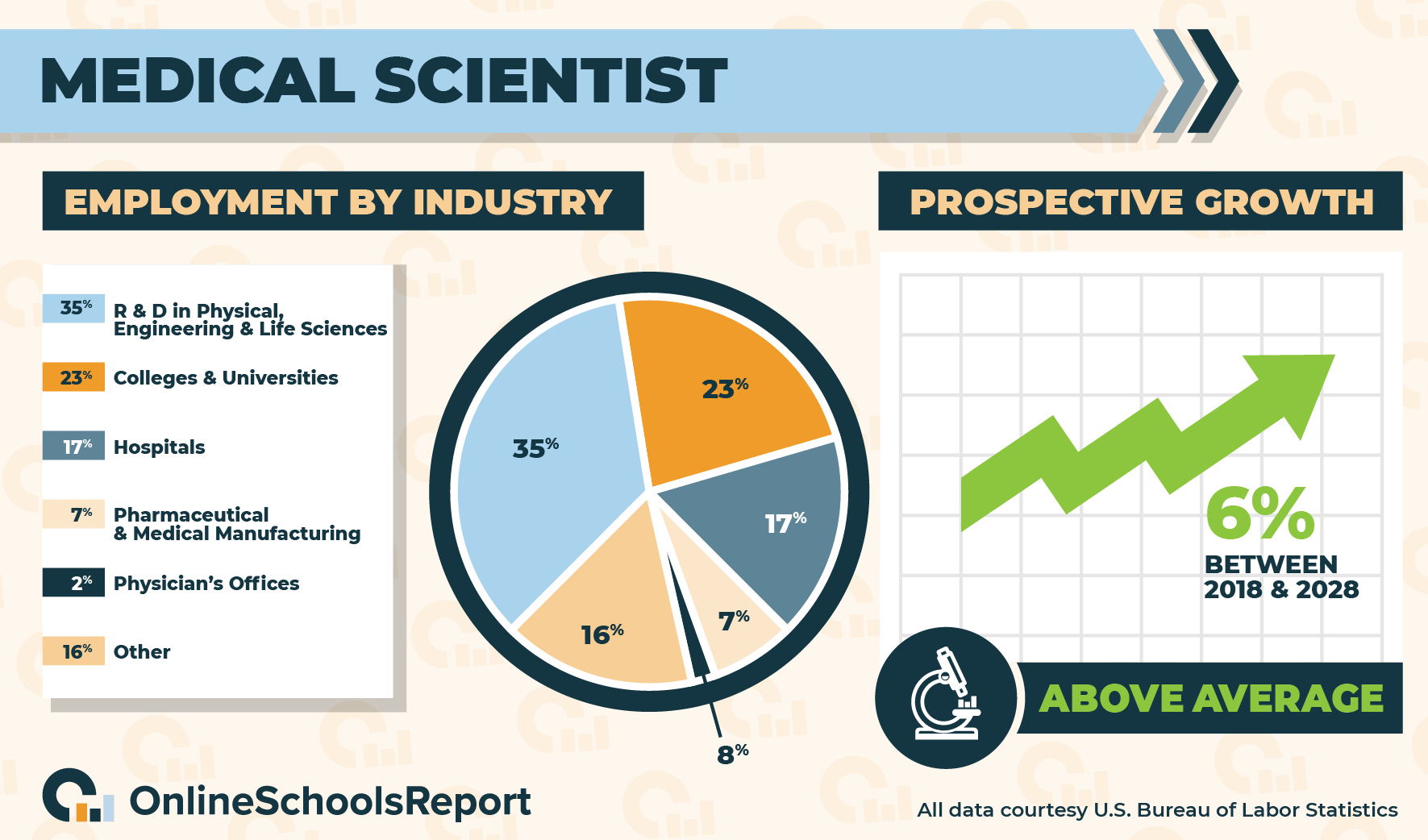
The average annual salary of a medical scientist is just about $89,000, according to the Bureau of Labor Statistics. Data from the BLS also states that there are roughly 138,000 medical science jobs in the U.S. That number is expected to grow at a rate of 6% in the years spanning 2018–2028, which is faster than the average rate of growth in many other professions.
Also according to the BLS, 35% of all medical scientists work in research and development in the physical, engineering, and life sciences. Following that, 23% work for colleges and universities and 17% work in the hospital setting. That’s while an additional 7% work in pharmaceutical and medical manufacturing.
For more information about careers in medical science, try looking into one of the many professional organizations related to the field, most notably the American Society for Clinical Laboratory Science (ACLS).
Biological Technician
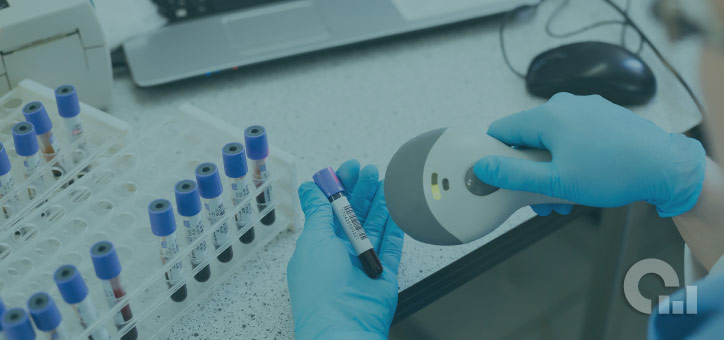
Biological technicians, sometimes called laboratory assistants, play an important role in the laboratory testing process. It’s a natural fit for someone with an educational background in clinical research.
Working closely with biological and medical scientists, biological technicians perform maintenance tasks in the lab. This can include cleaning laboratory instruments and equipment, ranging from microscopes and scales to pipettes and test tubes. They also play a part in gathering and preparing biological samples such as blood and bacteria cultures.
Biological technicians also get to conduct experiments, document their work, analyze data, and interpret results. These findings are often summarized in a written report, developed in part by the biological technician.
Needless to say, patience, curiosity, and attention to detail are all important attributes for people who excel in this line of work.
A bachelor’s degree is most often the minimum educational requirement to become a biological technician, though advanced degrees may increase job opportunities and income potential. Common bachelor’s degrees for biological technicians include biology, chemistry, or a science-related major like clinical research.
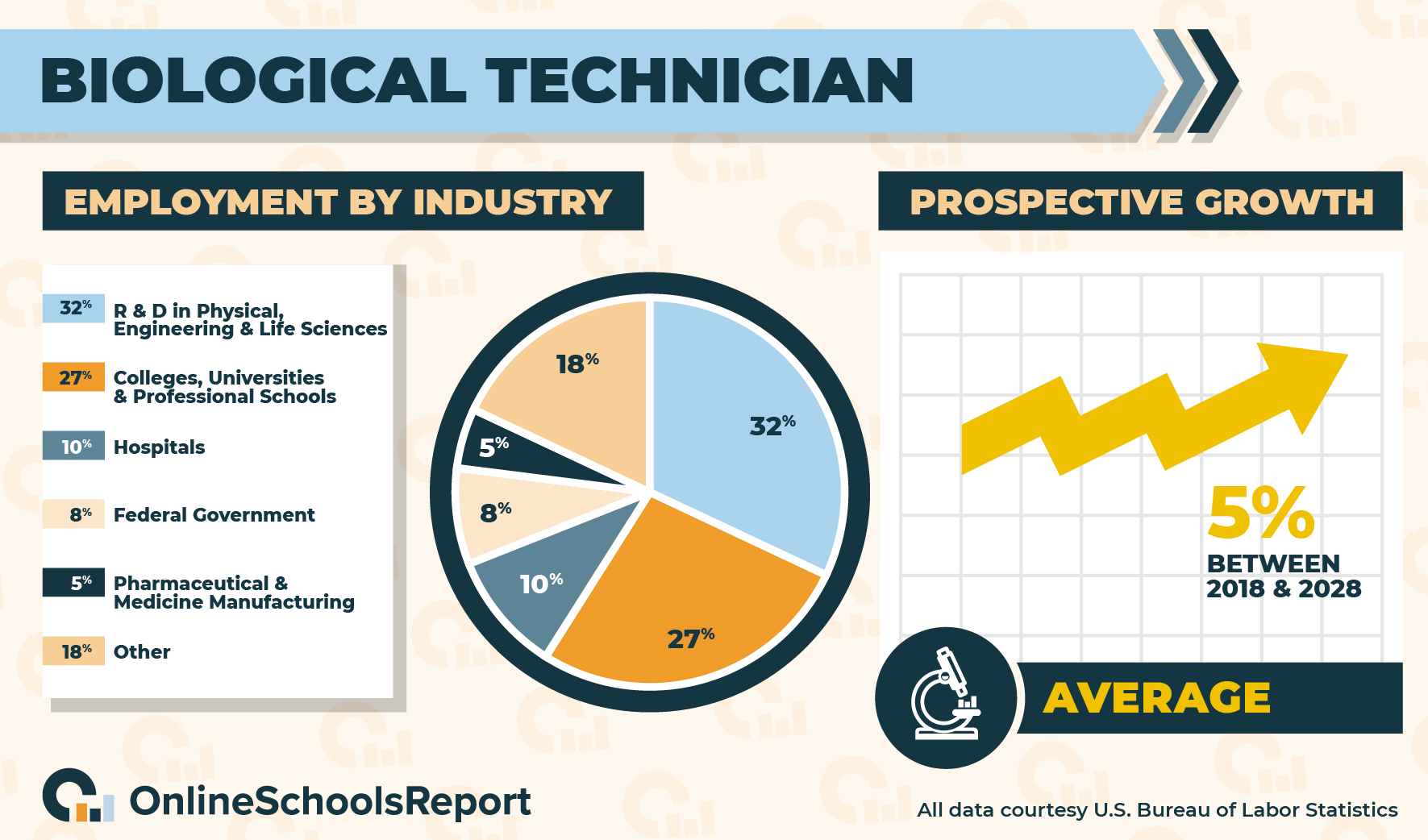
According to the Bureau of Labor Statistics, biological technicians make just about $46,000 a year. There are also about 88,000 technician positions across the U.S. In the decade spanning 2018–2028, that number is expected to grow at a rate of 5%, which is about average compared to many other lines of work.
BLS data also states that 32% of all biological technicians work in research and development in the physical, engineering, and life sciences. Following that, 27% work at colleges, universities, and professional schools. That’s while an additional 10% work for hospitals, and 8% work for the federal government. The final 5% work in pharmaceutical manufacturing.
States with strong employment numbers for biological technicians include California and Texas. Important professional organizations for biological technicians include the American Institute of Biological Sciences, the Institute of Food Technologists, the American Society for Biochemistry and Molecular Biology, and the American Society for Nutritional Sciences.
Clinical Lab Technologists and Technicians

Similar to a biological technician, clinical lab technologists and technicians also work in the lab environment. Different from biological technicians, however, clinical lab technologists and technologists support a broader range of experiments beyond those related to biology.
Tasks commonly performed by clinical lab technologists and technicians include analyzing and recording research and tests on bodily fluids. Technologists and technicians also study blood samples for use in transfusions.
Interested in operating sophisticated lab equipment? Clinical lab technologists and technicians do that too, using state-of-the-art lab equipment capable of performing several tests simultaneously.
Logging data and updating medical records is also part of the job of a clinical lab technologist and technician. They also discuss results and findings with physicians.
At a minimum, a bachelor’s degree is required to become a clinical lab technologist and technician. Most hold degrees in a science-related major like clinical research. Some states require a license from the state’s department of health, the state’s board of occupational licensing, or The American Society for Clinical Laboratory Science.
Associate degrees are also available in clinical laboratory science through vocational and technical schools. Pairing a bachelor’s degree with a certificate in clinical laboratory science can greatly improve employment opportunities.
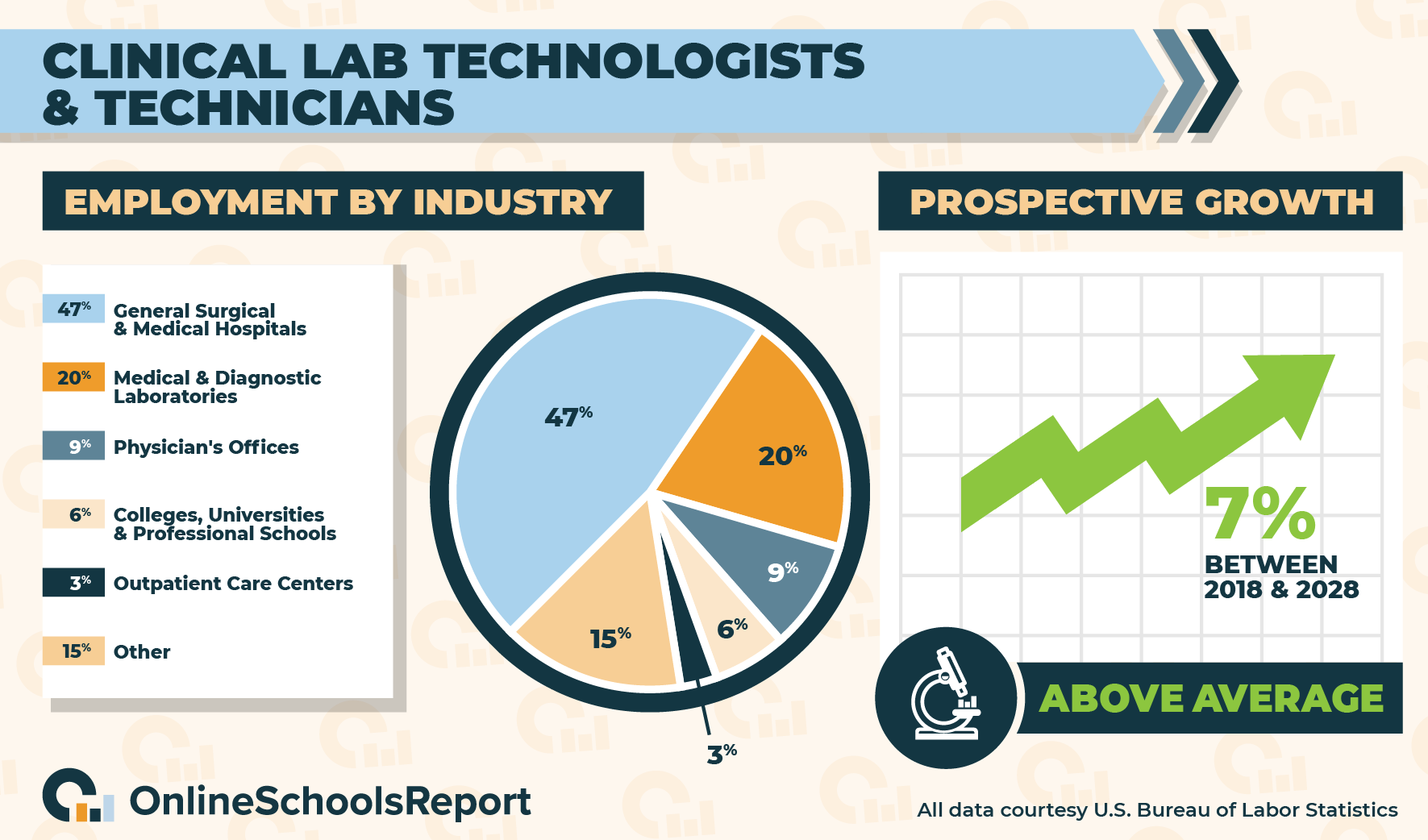
According to the Bureau of Labor Statistics, clinical lab technologists and technicians make about $53,000 annually, and there are about 338,000 jobs in the U.S. In the decade spanning 2018–2028, that number is expected to increase at a rate of 7%, which is above average for many other careers.
Also according to the BLS, 47% of all clinical lab technologists and technicians work in general surgical and medical hospitals, while 20% work in medical and diagnostic laboratories. An additional 9% work in physician’s offices and 6% work in junior or community colleges, colleges, universities, and professional schools. Following that, 3% work in outpatient care centers.
States with high levels of employment for clinical lab technologists and technicians include California and Texas.
Medical Assistants

Medical assistants perform similar tasks to lab technicians and technologists. The difference being medical assistants are employed in the medical environment rather than in a lab setting.
There are primarily four different kinds of medical assistants: administrative medical assistants, clinical medical assistants, ophthalmic and optometric medical assistants, and podiatric medical assistants.
All of these are a natural fit for those with an educational background in clinical research.
No matter the work environment, however, medical assistants complete many fascinating and crucial administrative and clinical tasks for medical professionals.
These tasks can include meticulously recording a patient’s medical history and personal information. Medical assistants may also measure vital signs like blood pressure, or help the doctor or physician in a broad range of other tasks related to patient examinations and medical procedures.
Medical assistants also commonly prepare blood tests samples for laboratory tests and enter detailed patient information into medical records. With the rise of electronic health records (EHRs), patient information is moving from paper to electronic records, making computer and IT skills a crucial part of the work of a medical assistant.
It is possible to work as a medical assistant with just a high school diploma and on-the-job training. Degrees and certificates are offered from community colleges and vocational schools, and many medical assistants work in the field with degrees in related subjects like clinical research.
Although no licensing or certification is technically required to become a medical assistant, certification is offered through organizations such as the American Association of Medical Assistants (AAMA), among many others.
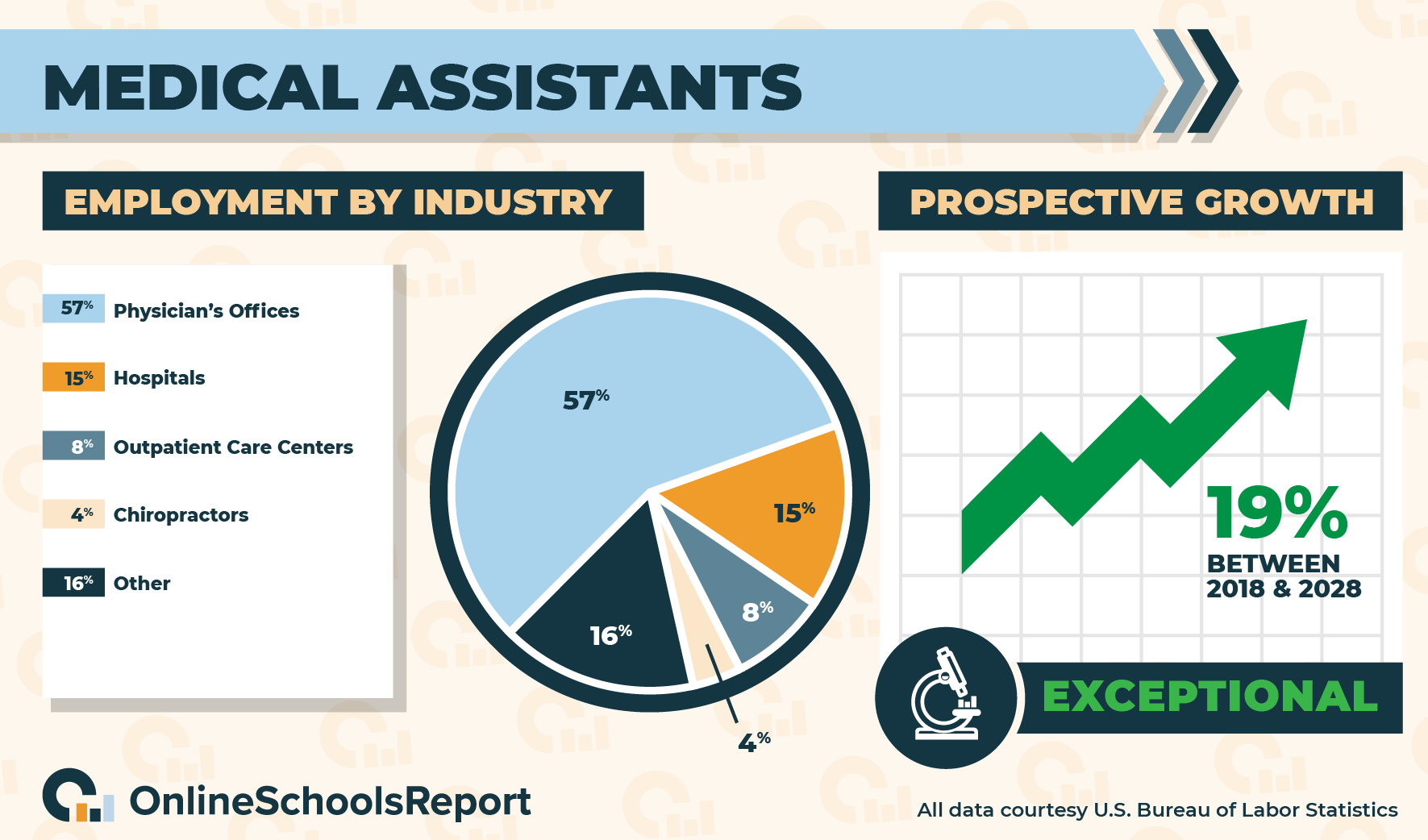
The average annual salary of a medical assistant is about $35,000 a year, according to the Bureau of Labor Statistics. There are just a little more than 725,000 medical assistant jobs in the U.S. That number is expected to grow at an astonishing rate of 19% in the decade spanning 2018–2028, which is roughly four times the national average.
Also according to the BLS, 57% of all medical assistants work in the offices of physicians. Following that, 15% work in hospitals, 8% work in outpatient care centers, and 4% of all medical assistants work in the offices of chiropractors. States with strong employment numbers for medical assistants include California and Texas.
Medical and Health Services Manager

Another career made possible by a degree in clinical research is that of a medical and health services manager.
Working closely with health care providers, there are three common types of medical and health services managers: nursing home administrators, clinical managers, and health information managers.
Across these different specialties, medical and health services managers direct the business activities for all sorts of health care facilities. Their areas of concern are efficiency in delivering high-quality services and ensuring that their business remains up-to-date with relevant laws and regulations.
Medical and health services managers also develop goals and objectives for the organization, manage finances, and play a part in recruiting and supervising staff members, which can include developing and maintaining employee work schedules.
Other work common for medical and health services managers includes keeping and organizing crucial records, maintaining data points such as how many inpatient beds are currently in use. They also remain in constant communication with department heads and other medical staff.
A bachelor’s degree in health administration or a related subject is required to become a medical and health services manager, though graduate degrees in health administration are offered from a wide variety of institutions. An undergraduate degree in clinical research could be a great starting point to enter a program of this nature.
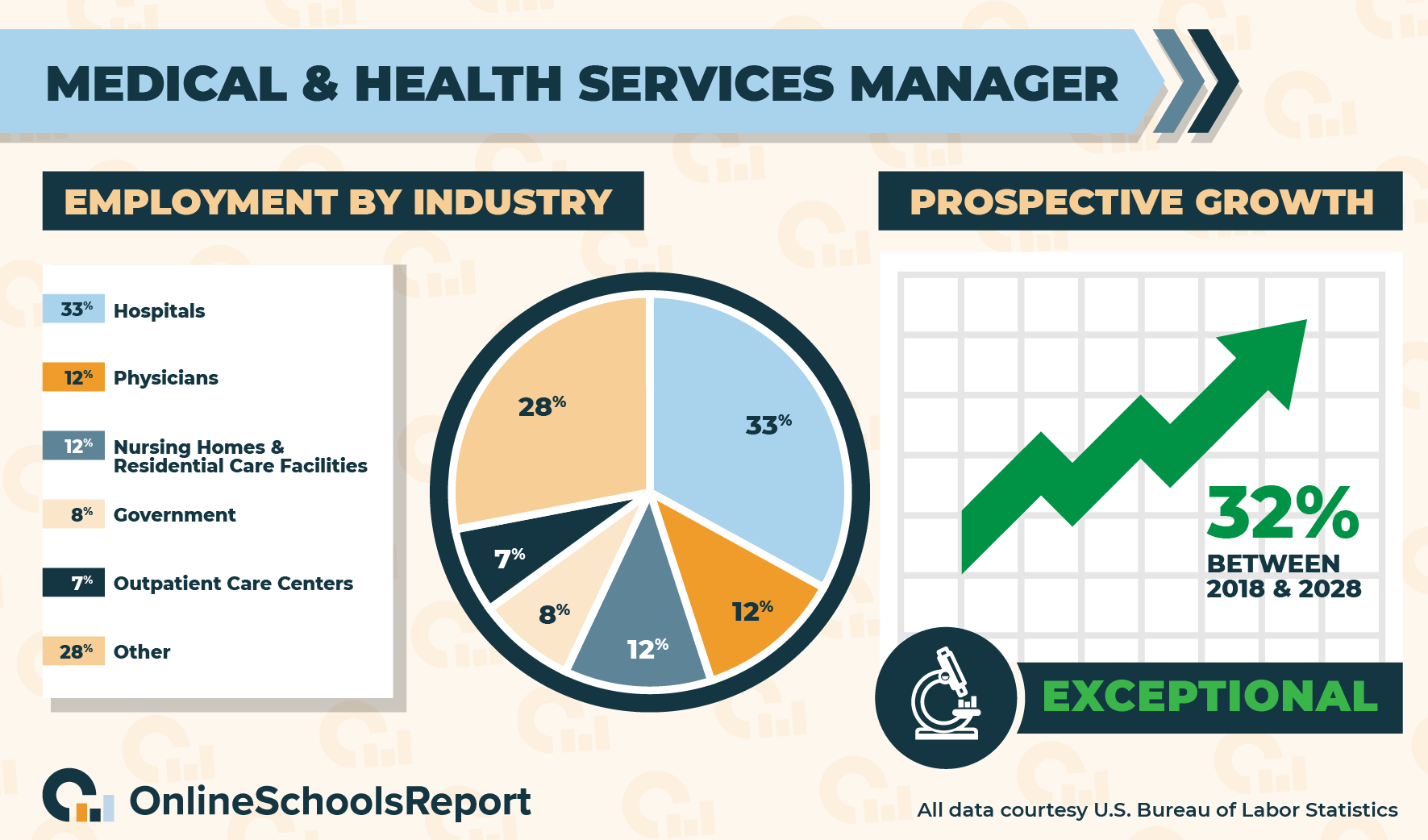
Data from the Bureau of Labor Statistics states the average annual salary of medical and health services managers is a little less than $101,000 a year, and there are just about 422,000 positions in the U.S. In the years spanning 2018–20228, that number is projected to grow at an astounding rate of 32% percent, over five times the rate of growth in other professions.
Also according to the BLS, 33% of medical and health services managers work for hospitals while 12% for physicians. An additional 12% work in nursing homes and residential care facilities, 8% work for the government, and 7% work in outpatient care centers. States with strong employment numbers in this profession include California and Texas.
Clinical Research Degrees
Ready to begin an exciting career in clinical research? Find your path with any one of the career options below.
Associate Degree in Clinical Research
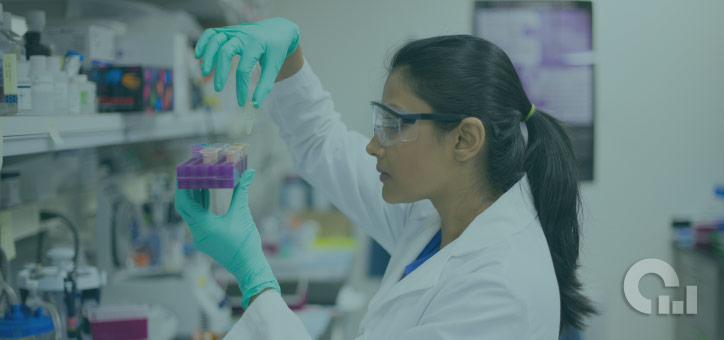
An associate degree in clinical research is perhaps the most direct way to qualify you to work as a clinical research associate (CRA). An Associate of Science degree (AS) is also a great place to start for anyone looking to transfer credits to a four year college and earn a bachelor’s degree, saving both time and money.
Associate of Applied Science degrees (AAS), however, are another great option to join the workforce as quickly as possible. Credits earned in an AAS program cannot always be transferred to another degree program, though, so make sure you do your research before making any final decisions.
No matter the kind of associate degree program, coursework covered will include topics like human anatomy, research writing, clinical trial management, and patient legal concerns, as well as general education. Overall, these programs are vocational in nature, putting a priority on hands-on experience.
Many who graduate from associate degree programs in clinical research go on to earn additional certification through the Association of Clinical Research Professionals, which increases employment opportunities and income potential. Employers often require this certification as well as a postsecondary degree or diploma.
In addition, many employers require clinical research associates to have up to three year’s experience in a lab setting. Many gain that experience through internships or through work as a research aide.
One common career path for those who hold an associate degree in clinical research is to become a clinical laboratory technician. Using biomedical instrumentation and other forms of health care technology, clinical laboratory technicians help physicians provide the best care possible for their patient.
Associate degree programs of any sort require a high school diploma or equivalent, with a minimum GPA of 2.0, though this can vary between programs. SAT and ACT scores may also be required. Some programs are offered completely online or in a hybrid format. Most associate degree programs consist of 60 credits, which many students complete in about two years.
Bachelor’s Degree in Clinical Research

There are several great bachelor’s degree options for those continuing their education beyond an associate degree in clinical research.
Some schools offer a Bachelor of Science in Clinical Science, others offer a Bachelor of Science in Clinical Laboratory Science, and still others offer a Bachelor of Science in Medical Laboratory Science (BSMLS). There are also Bachelor of Science degrees available in Clinical Research Management.
Regardless of the degree path chosen, clinical research degree programs provide an education in medicine, science, medical business, and clinical research, among other topics. Some areas of emphasis even include dentistry.
In addition, BS programs in clinical research teach the legal and ethical limits of lab research, as well as how to interpret certain chemical and biological principles through laboratory findings.
Topics common in clinical research coursework can include microbiology, organic chemistry, and precalculus, among many others. A solid foundation in biology, general chemistry, immunology, and genetics and statistics will also be provided.
In general, BS degrees in clinical research move away from the vocational and hands-on nature of an associate degree program toward the theoretical, research, and leadership-related aspects of the profession.
Post-graduation, many students go on to work in the health care sector and the biomedical industry. Others find research-based jobs in clinical laboratories as well as hospitals. The armed forces also hire qualified clinical researchers.
To receive certification as a clinical research coordinator from the Association of Clinical Research Professionals, which is just one of the many certifications available from the organization, requires 3,000 hours of professional experience. Of these hours, 1,500 can be satisfied by holding a clinical research degree from a program that’s accredited by the Council for Higher Education
Prerequisites for any bachelor’s degree program are a high school diploma or equivalent with a GPA of at least 2.0, though minimum GPA requirements may vary. Many students transfer credits from a community or junior college. SAT and ACT scores may also be required.
Bachelor’s degree programs typically require the completion of 120 credits before graduation, or about 40 college courses. This takes most students about four years. Programs are offered in-person and in a hybrid model. Many affordable options exist online as well.
Master’s Degree in Clinical Research

A Master of Science (MS) degree in Clinical Research is the penultimate step in the educational career of a clinical science professional. Other master’s degree options include a master’s in clinical research & regulatory affairs and a master’s degrees in clinical research management, among others
These degrees are meant for students interested in working as a scientist, researcher, teacher, or in management and leadership in the setting of clinical research.
Among all degree options, crucial coursework in any MS program in clinical research covers topics such as the legal and ethical limits of research on humans and animals. Students will also learn how to interpret and apply those findings. In addition, these programs will ground students in identifying and measuring outcomes, conducting research, and publishing research reports.
Earning a MS in Clinical Research qualifies a graduate to work as a senior clinical research associate or a clinical laboratory scientist. Others go on to become drug developers or contract researchers. Most earn additional certification from the Association of Clinical Research Professionals, while some already hold certification prior to entering the graduate degree program.
Master’s degree programs also require a terminal thesis project, though some MS degrees allow fieldwork and practicums as a substitute.
A bachelor’s degree in clinical research or a related subject is a prerequisite for most master’s degree programs, as is a minimum GPA of 3.0, though these requirements vary. A TOEFL score of between 250 and 500 may also be required, as can previous lab experience earned through internships or former work experience. Letters of recommendation or statements of personal intent may also be required.
Doctorate Degree in Clinical Research

Like any field of study, a doctorate-level degree is the last and final step in the educational career of a clinical researcher.
One thing to note about PhD programs in clinical research is that most require a medical degree as a prerequisite, such as a Doctor of Medicine (MD), Doctor of Pharmacy (Pharm.D.), or a Doctor of Dental Surgery (DDS).
Some programs do, however, accept students with master’s degrees in nursing, public health, or clinical research, among others. Areas of emphasis within clinical research PhD programs include health services, health information technology, or clinical investigations.
Clinical doctorate degrees are also available. Doctorate degrees differ from PhD programs in clinical research in that they have a more applied approach to the subject matter rather than a focus on the development of original research.
Other doctorate-level degrees related to clinical research include a PhD in Experimental Medicine, or a PhD in Bioanalytical Methods.
Most often, a dissertation is required to complete a doctorate degree, as are clinical rotations. Through a combination of coursework, field work, and practicums, clinical research doctorate and PhD programs teach topics like medical research and experimental design.
In addition, coursework covers medical research technology, ethics in medical research, and medical research laboratory practices, among other topics. Graduates are qualified to teach clinical science or to work in research for pharmaceutical companies and hospitals, among other settings.
A master’s degree is a prerequisite for any PhD program. Submitting additional test scores may also be required. PhD programs commonly commonly require between 60 and 120 credits to complete. Most students do so in less than three years, though some programs allow students to take up to eight years conducting research while writing and defending their dissertation.





